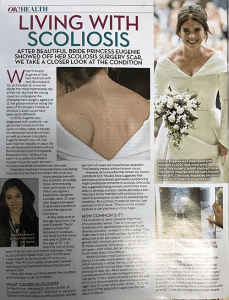If you pick up a copy of OK magazine this week you’ll find some great info form our own Dr Paul Irvine in the health section. We’re really excited to be getting this message out about scoliosis and how to spot it, since early detection makes such a huge difference. This week, let’s review some of the key symptoms to look out for.
Scoliosis : what to look out for
Two to three percent of adolescents between the age of 10 and 15 will develop scoliosis. That might seem like a small percentage, but as we pointed out in OK, it’s about one per class at school. Among adults over 50, the rate is as high as 40% – this means that you almost certainly know at least a few people with scoliosis.
Scoliosis is a complex condition and can affect individuals in different ways. In fact, scoliosis is often difficult to detect early on, which is why screening is so important.
When scoliosis has first started to develop, visual symptoms are often the main issue – uneven shoulders, hips, or a rib hump are commonly noticed. While these symptoms don’t necessarily pose a significant health risk on their own, they are strongly associated with psychological problems, such as low self-esteem, anxiety and depression.
Once scoliosis develops and becomes more pronounced it can have an impact on everyday life as well as being more obvious visually. Symptoms might include:
- Changes with walking. When the spine abnormally twists and bends during walking, it can cause the hips to be out of alignment which changes a person’s gait or how they walk. You might also notice you get tired quickly when walking.
- Reduced range of motion. You might notice a reduced flexibility, or even pain and stiffness when moving.
- Trouble breathing. If the spine rotates enough and diverges from its normal position enough, the rib cage can twist and tighten the space available for the lungs.
- Cardiovascular problems. Similarly, if the rib cage twists enough, reduced spacing for the heart can hamper its ability to pump blood.
- Many scoliosis patients report back pain ranging from moderate to severe. More research is required to determine if scoliosis is the main cause of the pain or if the pain is associated with issues, such as muscle tightness, which come with scoliosis, but pain is nonetheless often the symptom which causes people to seek treatment.
How can I screen for scoliosis?
Screening for scoliosis is easy and takes about 5 minutes – you can learn more about how to screen for scoliosis here, or use our ScoliScreen tool, which will guide you through the process.
Spot scoliosis early and improve your prognosis!
Early detection Is especially important in scoliosis cases since research has shown a direct link between the age of detection and the outcomes achievable. Today, through modern bracing technology, it has been demonstrated that conservative treatment with a brace is now highly effective in treating juvenile idiopathic scoliosis. In one recent study of 113 patients, the vast majority achieved a complete curve correction and only 4.9% of patients needed surgery[1]
In the 2015 study, it was shown that curve correction was accomplished in 88 patients (77.8%) and stabilization was obtained in 18 patients (15.9%). Only 7 of the patients (6.19%) had progression of their scoliosis, and only 4 of these were recommended for surgery. Critically however, the study also demonstrated that treatment appears to be more effective with curves under 30° (incidence of surgery: 1.6%) than curves over 30° (incidence of surgery: 5.5%) – which strongly suggests the need to catch curves early.[2]
Have questions about scoliosis?
If you have questions about scoliosis, feel free to get in touch with us by phone or email – or upload your x-rays for a free scoliosis assessment.
[1] ‘Brace treatment in juvenile idiopathic scoliosis: a prospective study in accordance with the SRS criteria for bracing studies – SOSORT award 2013 winner‘ and Angelo G Aulisa, Vincenzo Guzzanti, Emanuele Marzetti,Marco Giordano, Francesco Falciglia and Lorenzo Aulisa, Scoliosis 2014 9:3 DOI: 10.1186/1748-7161-9-3
[2] Ibid.



